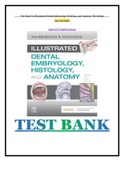Exam (elaborations)
(Complete)Test Bank For Illustrated Dental Embryology Histology and Anatomy 5th Edition| Complete| Latest| All Chapters|
- Course
- Institution
This is not the Text book......... You are downloading!!! (Complete)Test Bank For Illustrated Dental Embryology Histology and Anatomy 5th Edition| Complete| Latest| All Chapters| (Complete)Test Bank For Illustrated Dental Embryology Histology and Anatomy 5th Edition| Complete| Latest| All Chapte...
[Show more]



